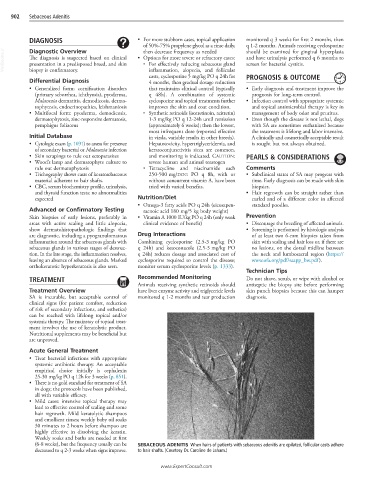Page 1803 - Cote clinical veterinary advisor dogs and cats 4th
P. 1803
902 Sebaceous Adenitis
DIAGNOSIS • For more stubborn cases, topical application monitored q 3 weeks for first 2 months, then
of 50%-75% propylene glycol as a rinse daily, q 1-2 months. Animals receiving cyclosporine
Diagnostic Overview
VetBooks.ir The diagnosis is suspected based on clinical • Options for more severe or refractory cases: and have urinalysis performed q 6 months to
should be examined for gingival hyperplasia
then decrease frequency as needed
screen for bacterial cystitis.
○ For effectively reducing sebaceous gland
presentation in a predisposed breed, and skin
biopsy is confirmatory.
inflammation, alopecia, and follicular
casts, cyclosporine 5 mg/kg PO q 24h for PROGNOSIS & OUTCOME
Differential Diagnosis 4 months, then gradual dosage reduction
• Generalized form: cornification disorders that maintains clinical control (typically • Early diagnosis and treatment improve the
(primary seborrhea, ichthyosis), pyoderma, q 48h). A combination of systemic prognosis for long-term control.
Malassezia dermatitis, demodicosis, derma- cyclosporine and topical treatments further • Infection control with appropriate systemic
tophytosis, endocrinopathies, leishmaniosis improves the skin and coat condition. and topical antimicrobial therapy is key in
• Multifocal form: pyoderma, demodicosis, ○ Synthetic retinoids (isotretinoin, acitretin) management of body odor and pruritus.
dermatophytosis, zinc-responsive dermatosis, 1-3 mg/kg PO q 12-24h until remission • Even though the disease is not lethal, dogs
pemphigus foliaceus (approximately 6 weeks); then the lowest, with SA are sometimes euthanized because
most infrequent dose (reported effective the treatment is lifelong and labor intensive.
Initial Database in vizsla, variable results in other breeds). A clinically and cosmetically acceptable result
• Cytologic exam (p. 1091) to assess for presence Hepatotoxicity, hypertriglyceridemia, and is sought but not always obtained.
of secondary bacterial or Malassezia infection keratoconjunctivitis sicca are common,
• Skin scrapings to rule out ectoparasites and monitoring is indicated. CAUTION: PEARLS & CONSIDERATIONS
• Wood’s lamp and dermatophyte culture to severe human and animal teratogen
rule out dermatophytosis ○ Tetracycline and niacinamide each Comments
• Trichography shows casts of keratosebaceous 250-500 mg/DOG PO q 8h, with or • Subclinical states of SA may progress with
material adherent to hair shafts. without concurrent vitamin A, have been time. Early diagnosis can be made with skin
• CBC, serum biochemistry profile, urinalysis, tried with varied benefits. biopsies.
and thyroid function tests: no abnormalities • Hair regrowth can be straight rather than
expected Nutrition/Diet curled and of a different color in affected
• Omega-3 fatty acids PO q 24h (eicosapen- standard poodles.
Advanced or Confirmatory Testing taenoic acid 180 mg/5 kg body weight)
Skin biopsies of early lesions, preferably in • Vitamin A 1000 IU/kg PO q 24h (only weak Prevention
areas with active scaling and little alopecia, clinical evidence of benefit) • Discourage the breeding of affected animals.
show dermatohistopathologic findings that • Screening is performed by histologic analysis
are diagnostic, including a pyogranulomatous Drug Interactions of at least two 6-mm biopsies taken from
inflammation around the sebaceous glands with Combining cyclosporine (2.5-3 mg/kg PO skin with scaling and hair loss or, if there are
sebaceous glands in various stages of destruc- q 24h) and ketoconazole (2.5-3 mg/kg PO no lesions, on the dorsal midline between
tion. In the late stage, the inflammation resolves, q 24h) reduces dosage and associated cost of the neck and lumbosacral region (https://
leaving an absence of sebaceous glands. Marked cyclosporine required to control the disease; www.ofa.org/pdf/saapp_bw.pdf).
orthokeratotic hyperkeratosis is also seen. monitor serum cyclosporine levels (p. 1333).
Technician Tips
TREATMENT Recommended Monitoring Do not shave, scrub, or wipe with alcohol or
Animals receiving synthetic retinoids should antiseptic the biopsy site before performing
Treatment Overview have liver enzyme activity and triglyceride levels skin punch biopsies because this can hamper
SA is incurable, but acceptable control of monitored q 1-2 months and tear production diagnosis.
clinical signs (for patient comfort, reduction
of risk of secondary infections, and esthetics)
can be reached with lifelong topical and/or
systemic therapy. The mainstay of topical treat-
ment involves the use of keratolytic product.
Nutritional supplements may be beneficial but
are unproved.
Acute General Treatment
• Treat bacterial infections with appropriate
systemic antibiotic therapy. An acceptable
empirical choice initially is cephalexin
25-30 mg/kg PO q 12h for 3 weeks (p. 851).
• There is no gold standard for treatment of SA
in dogs; the protocols have been published,
all with variable efficacy.
• Mild cases: intensive topical therapy may
lead to effective control of scaling and some
hair regrowth. Mild keratolytic shampoos
and emollient rinses; weekly baby oil soaks
30 minutes to 2 hours before shampoo are
highly effective in dissolving the keratin.
Weekly soaks and baths are needed at first
(6-8 weeks), but the frequency usually can be SEBACEOUS ADENITIS When hairs of patients with sebaceous adenitis are epilated, follicular casts adhere
decreased to q 2-3 weeks when signs improve. to hair shafts. (Courtesy Dr. Caroline de Jaham.)
www.ExpertConsult.com

